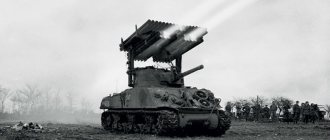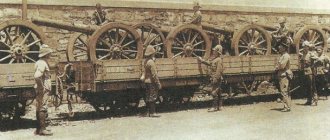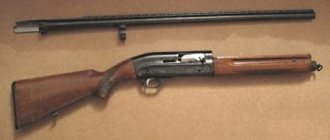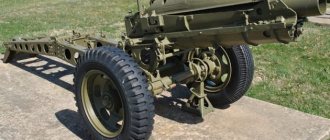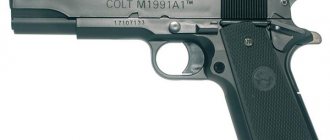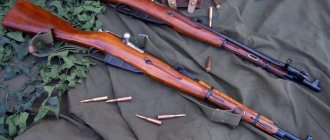Bristol Blenheim
The aircraft was developed by the Bristol Aeroplane Company in the mid-1930s, based on the design of the Bristol 142 aircraft.
Serial production began at the end of 1936[2] and amounted to 4422 aircraft.
The bomber was widely used during World War II.
In the Finnish Air Force
Finnish Blenheim Mk.
I. 1939 As of October 30, 1939, before the start of the Soviet-Finnish War, Blenheim Mk.I bombers were in service with the LLv-44 and LLv-46 air squadrons of the 4th air regiment of the Finnish Air Force, which were based at Luonetjervi airfield [3] .
On December 1, 1939, during an attack on a column of Soviet troops in the Tsalka area, the first Finnish Blenheim was shot down by fire from the ground[2].
On December 14, 1939, the first meeting of the Finnish Blenheim (tail number BL-105) with the Red Army Air Force took place, during which the Blenheim, increasing its speed to maximum and gaining altitude, managed to escape from the flight of three I-153 fighters that had begun the attack[ 2]. During the next meeting, the discovered Blenheim managed to hide from Soviet fighters in the clouds. During the debriefing, it was found that the external similarity of the Blenheim to a Soviet high-speed bomber made it difficult for Red Army fighter pilots to recognize the target in a timely manner[4].
On December 20, 1939, the first meeting of Blenheims with I-16 fighters took place - a flight of three Blenheims LLv-46, after a bomb attack on a convoy of Soviet troops in the Saamajärvi-Tulemayärvi area, was attacked by several flights of I-16s, all three bombers were damaged , one gunner was killed. According to Finnish data, one I-16 was shot down by gunfire [2].
On February 19, 1940, the sixth Finnish Blenheim was destroyed during its attack on a military hospital (the attack on which was launched despite the presence of Red Cross insignia).[4] The bomber was shot down over Lake Ladoga by a flight of three Red Army Air Force fighters (pilots Murazanov, A.P. Savushkin, Goryunov).
During the war, Finland received another 24 Blenheim bombers from Great Britain, 22 of which were transferred to the 4th Air Regiment (one Mk.IV was destroyed and another was severely damaged during the flight to Finland). According to official Finnish data, during the fighting, three Mk.I and four Mk.IV were shot down, and three more vehicles were seriously damaged; another 11 Blenheim aircraft were lost for other reasons. As a result, by the end of the war, 29 Blenheim bombers remained in service, only 11 of which were in combat-ready condition[3]. Most of the damaged aircraft were repaired after the end of the war (recognized as beyond repair and only 5 Blenheims were written off), but in the period from April 1940 to July 1941, 4 more aircraft were lost in accidents and disasters[2].
<… contentScore=”1483″> In August 1935, the RAF decided to replace the Avro Anson, which was used in coastal reconnaissance and as a light bomber.
Specification G.24/35 was issued, in accordance with which it proposed its own new variant - the Type 149, which was equipped with two Bristol Aquila engines and was very similar to the Blenheim Mk I. The Ministry of Aviation was not interested in this proposal, but later the car began to be considered as a potential reconnaissance aircraft A prototype was manufactured - a modernized Blenheim Mk I, on which the nose of the fuselage was lengthened to provide additional space to accommodate the navigator-observer and his equipment, power plant - Mercury VIII engines. The new variant was designated Blenheim Mk IV. The Ministry of Aviation, however, feared that the launch of the new Type 149 could disrupt the orderly production chain of the Blenheim production program, but the Type 149 was approved by the command of the Canadian Air Force for assembly in Canada under the designation Bolingbroke Mk I. The first Canadian-assembled aircraft was equipped with Mercury VIII engines, but the subsequent 18 vehicles, designated Bolingbroke Mk IV, already had Mercury XV engines and various equipment of Canadian and American production. Later variants included Bolingbroke Mk IV-W modifications with 1,200 hp Pratt & Whitney R-1830 Twin Wasp engines. e., as well as Bolingbroke Mk IV-T training aircraft. The British Air Ministry also remembered the Type 149, considering it as a temporary replacement until the Type 152 torpedo bomber, created at the Blenheim base, entered the troops. The decision was made to use the extended nose and stepped canopy of the Bolingbroke aircraft, and to provide increased range through the larger capacity of the wing fuel tanks. reserved the designation Type 149 for the new modification, and the British Air Force assigned it the designation Blenheim Mk IV. The new aircraft went into production at the end of 1938, but the first 68 aircraft were built with the old wing - with standard wing tank capacity. The power plant consisted of more powerful Mercury XV engines, due to which it was possible to increase the maximum take-off weight of the vehicle. The costs of equipping the aircraft with additional weapons turned out to be so high that the first Blenheim Mk IV retained the armament of the Mk I variant - two machine guns, but the armor was strengthened and the ability to externally carry 145 kg of bombs was provided when performing short-range flights. The first Blenheim Mk IV was received by the 90th Squadron, in March 1939; in total, these aircraft were in service with more than 70 squadrons. The Blenheim aircraft made the first reconnaissance flight over German territory - on September 3, 1939, it was carried out by Blenheim Mk IV from the 139th squadron, and the first bombing of Reich targets - on September 4, 1939. At the outbreak of war, the Blenheim Mk IV was used extensively by RAF Bomber Command until it was replaced in this role by the Douglas Boston and de Havilland Mosquito in 1942. Despite its weak defensive armament, the aircraft was often used during the day and without fighter cover. In squadrons based outside the metropolis, the Blenheim continued to operate much longer than in the European theater of operations. A total of 3,983 Blenheim Mk IV and Bolingbroke aircraft were produced, with the Blenheim Mk IV in service with both the British Air Force and the Free French, South African, Finnish and Greek air forces. An analogue of the Mk IF modification was the Blenheim Mk IVF night fighter. It was produced by converting from existing Blenheim Mk IV. The last of the Blenheim family was the Type 160, better known as the Bisley, which entered service in the summer of 1942 under the designation Blenheim MkV. Originally envisioned as a low-altitude close air support bomber, the aircraft, with its massive forward fuselage housing four machine guns, was eventually developed into a high-altitude bomber powered by Mercury XV or XXV engines. 945 of these aircraft were built, and the 18th Squadron was the first to receive them (in total, the aircraft entered six squadrons in the Middle East and four in the Far East). However, the plane turned out not very good - the maximum take-off weight increased by 17% could not be compensated for, the engines remained the same power. So when these bombers went toe-to-toe with Luftwaffe fighters during the Italian campaign, their losses were horrendous. TACTICAL AND TECHNICAL CHARACTERISTICS
Bristol Blenheim Mk IV
Type: light bomber with a crew of three Powerplant: two 905 hp Bristol Mercury XV radial engines. With. (675 kW) Flight characteristics: maximum speed at an altitude of 3595 m - 428 km/h; cruising speed at optimal altitude 319 km/h; initial rate of climb 457 m/min; service ceiling 8310 m; range 2350 km Weight: empty 4441 kg; maximum takeoff 6532 kg Dimensions: wingspan 17.17 m; length 12.98 m; height 3.00 m; wing area 43.57 m2 Armament: one 7.7 mm Vickers machine gun in the left wing plane, two 7.7 mm Browning machine guns in the dorsal Bristol turret and two 7.7 mm remote-controlled Browning machine guns in the ventral turret "Frazer-Nash" for shelling the rear hemisphere, as well as up to 454 kg of bombs in the bomb bay and 145 kg on the external sling
</…>
Blenheim Mk.IV, a reliable British classic
Born in the wake of British patriotism and the desire to create the fastest aircraft in the world, the Blenheim Mk.IV determined the direction of future development of aircraft manufacturing and set a new bar for aircraft performance. This aircraft, very advanced for its time, but already practically obsolete by the beginning of the war, made a significant contribution to the course of the war and the development of military aviation.
Lord Rothermere, owner of the influential Daily Mail newspaper, could not calmly react to news about the creation of increasingly more advanced and high-speed aircraft in other countries. He took it especially hard when Germany opened a commercial airline, for which the Heinkel He.70 Blitz, which had record speeds, was used. To soothe his bruised sense of British pride, Rothermere wanted to create an even faster passenger aircraft and found an ideal candidate, the prototype proposed as the Type 135.
Having received funding, the Bristol designers created on its basis the Type 142, an aircraft that, when it first took to the skies on April 12, 1935, was significantly faster than any aircraft in the Royal Air Force. Despite the fact that the aircraft was built for passenger transportation, its design had all the features of a racing aircraft - a miniature cockpit and a streamlined elongated fuselage. As expected, the aircraft immediately attracted the attention of the Air Force command, and its modification for military needs began. The main changes included raising the wing to accommodate a 450 kg (1,000 lb) bomb load and armament, and an unusually full glazing of the nose. The result was a modification of the Mk.1 (Mark 1), which first took to the skies on June 25, 1936.
The pointed glass nose of the original Blenheim Mk I was soon replaced by the extended nose of the Blenheim Mk IV. As a result of a number of serious improvements and modernization of weapons, the Blenheim Mk.IV (Mark 4) was developed, which is presented in the game War Thunder. This is the final modification with two Vickers K machine guns in the upper defensive turret and a unique ventral turret with two Browning machine guns and a periscope sight. Despite the complexity of control, in real conditions, as in the game, it is vital for the defense of the lower hemisphere, which previously remained defenseless. The unusual-looking nose glazing provided the pilot with good visibility of the runway during takeoff and landing. The bomb load available in the game (4 bombs of 117 kg or 2 bombs of 225 kg) reflects historical data and shows the limitations in the use of this machine for the military sphere, however, it is not so small, as the experience of using the aircraft in many military theaters has shown actions.
In the game, this machine is at the first rank, and often encounters opponents that would have been historically likely to meet in the sky: these are late biplane fighters and early monoplane fighters, up to the most common fighters, such as the Bf.109E and A6M2 . Compared to early biplanes, this machine has an advantage in speed with almost equal armament. The pilot even has at his disposal one Browning machine gun, located, curiously, almost at the very edge of the left wing. Against fighters with a higher BR, the best tactic is to take advantage of the relatively high speed and retreat to the side of their own, complicating the pursuit by firing from the turret. There is even one vantage point where both turrets can fire at the same time.
The initially available Blenheim is quite weak, has a significantly reduced speed, carries only one bomb and is armed with not the best cartridge belts. Before your first mission, unlock first the radiator to increase speed (this is an exception, I usually recommend upgrading weapons first) and then the MBC-B bomb racks. After unlocking the second rank, select the 7mm Turret and when it is unlocked, select the Utility Ribbon. Two turret upgrades are possible, the first for the upper turret with Vickers K, and the second for the ventral turret. Unlock them along with power upgrades. More important is upgrading the crew to Expert level (in version 1.53, crew level 5 or higher is required).
The results of the actual use of these aircraft during the war were not clear. There have been both serious successes and crushing failures, and similar results are possible in the game. The lack of protection for the lower hemisphere was quickly realized and appropriate weapons were added, but this was preceded by many losses. The modification of the aircraft presented in the game already has a ventral turret installed. Fighters can only avoid fire from defensive turrets using a classic attack from above at high speed, and it is necessary to use 12.7 mm or more powerful weapons, since 7 mm cartridges will not cause much damage to the aluminum skin of the aircraft.
Rapid technological progress in the 30s led to the fact that by 1940 the Blenheim was already outdated, but developments in the creation of light high-speed bombers made it possible to build a larger and more effective anti-ship Beaufort, which, in turn, became the basis for the creation powerful Beaufighter (both of these vehicles are in the game). There were three main importers of the aircraft outside the UK. A copy was produced for the Canadian Air Force, called "Bolingbroke". Blenheims were supplied to Yugoslavia and were also produced there under license (interestingly, the Do.17 was also assembled there). Finland also used these British bombers against the USSR, and Yugoslav spare parts provided by Germany continued to fly these aircraft long after the war. Blenheim's last flight took place in Finland in 1954. This aircraft is the best surviving example to date.

